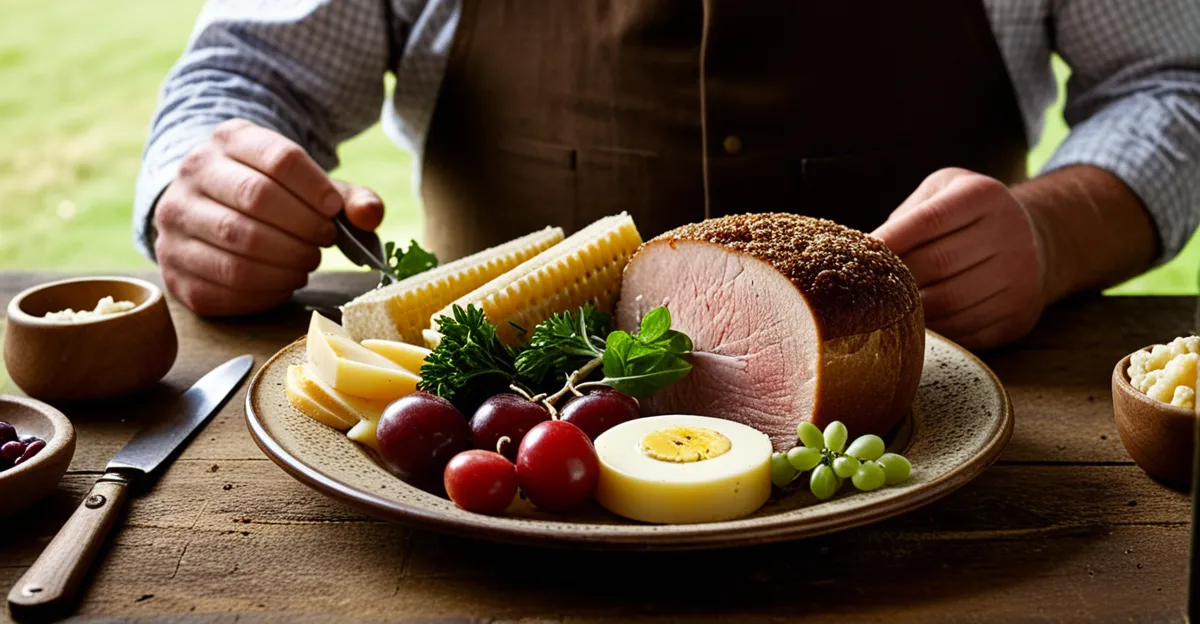Understanding the Traditional English Ploughman’s Lunch
The ploughman’s lunch is a cherished part of British food culture, representing a simple yet satisfying traditional English lunch. Its roots trace back to the early 20th century, designed as a hearty meal for agricultural workers—ploughmen—who needed substantial energy from locally available produce. The classic combination typically includes a generous helping of cheese, crusty bread, and pickles, symbolizing rural British fare.
Culturally, the ploughman’s lunch embodies the British emphasis on straightforward, wholesome meals. It gained popularity post-World War II when pub meals became more standardized, turning the ploughman’s lunch into a quintessential menu item. This tradition highlights the value placed on locally sourced, fresh ingredients in British cuisine.
In the same genre : What Are the Most Popular UK Dishes Across Different Regions?
Understanding the history of the ploughman’s lunch reveals more than just a meal; it offers insight into the social and historical fabric of Britain. The dish’s enduring appeal lies in its balance of textures and flavours, reflecting the heritage and identity embedded in British food culture.
Enjoying a traditional English lunch like the ploughman’s connects diners to a longstanding culinary tradition, making it a meaningful experience beyond simply eating.
This might interest you : What is the best way to bake a classic Victoria sponge cake?
Essential Components and Ingredients
Understanding the ploughman’s lunch ingredients is key to appreciating this traditional English lunch. The meal centers around robust, simple elements that showcase regional British produce, reflecting its origins in British food culture.
Cheese plays a starring role. Common choices include Cheddar, prized for its sharpness; Stilton, celebrated for its creamy blue veins; and Red Leicester, with its mild, nutty flavour. These cheeses bring authentic taste and texture, anchoring the platter.
Bread selection is equally important. Typically, a crusty loaf like a farmhouse white or a hearty wholemeal or brown bread is used. These varieties offer varying textures, perfect for soaking up flavours and providing a rustic feel true to traditional English lunch.
Accompaniments complete the dish. Pickled onions and Branston pickle add tang and sweetness, creating a balance with the salty cheese. Fresh elements such as apple slices, salad vegetables, and sometimes boiled eggs add freshness and variety.
Together, these ingredients form a harmonious plate that embodies the simplicity and wholesomeness prized in ploughman’s lunch history. Each component contributes to a satisfying, balanced meal that is both practical and steeped in British culinary heritage.
Step-by-Step Preparation Guide
Crafting an authentic ploughman’s lunch begins with careful assembly to honour its traditional English lunch roots. Start by selecting fresh ploughman’s lunch ingredients, ensuring cheeses like Cheddar, Stilton, or Red Leicester are cut into neat, bite-sized slices or wedges. Presenting cheese prominently is key, as it forms the plate’s flavour foundation.
Next, slice the chosen British bread—typically rustic, crusty loaves or wholemeal varieties—into thick, inviting pieces. These should be arranged around the cheese to encourage easy serving and complement its texture. A proper balance between cheese and bread helps emulate the classic feel of this dish.
Accompaniments such as pickled onions and Branston pickle are placed thoughtfully, adding contrasting flavours that brighten each bite. Fresh apple slices or crisp salad vegetables offer a refreshing counterpoint, enhancing the meal’s complexity. Boiled eggs can be halved and positioned decoratively to complete the platter.
When assembling, consider the platter’s visual appeal: group similar items, space ingredients evenly, and avoid overcrowding to maintain freshness. This method respects the ploughman’s lunch history by presenting the meal as a wholesome, rustic feast, ready to enjoy in the spirit of British food culture.
Serving Suggestions and Variations
When considering ploughman’s lunch serving tips, presentation plays a vital role. Traditionally, the meal is served on a large wooden platter to encourage sharing, reinforcing its rustic and communal origins in British food culture. However, using individual plates can offer a neat, personalized touch without losing authenticity.
Pairing the meal with suitable beverages enhances the experience. Classic combinations include traditional English ales, whose malty notes complement the sharpness of the cheeses. For those preferring non-alcoholic options, sparkling apple cider or chilled lemonades provide a refreshing contrast to the traditional English lunch’s rich flavours.
Variations of the ploughman’s lunch allow flexibility while maintaining authenticity. Swap out styles of bread or try milder cheeses for different textures and tastes. Regional twists might introduce cured meats or pickled vegetables beyond onions. These adaptations honor the dish’s evolving place in British cuisine, balancing respect for ploughman’s lunch history with modern palates.
Adapting the serving style and ingredients not only personalizes the meal but also demonstrates the versatility inherent in this cherished British tradition. These choices keep the ploughman’s lunch both relevant and enjoyable for today’s diners.






